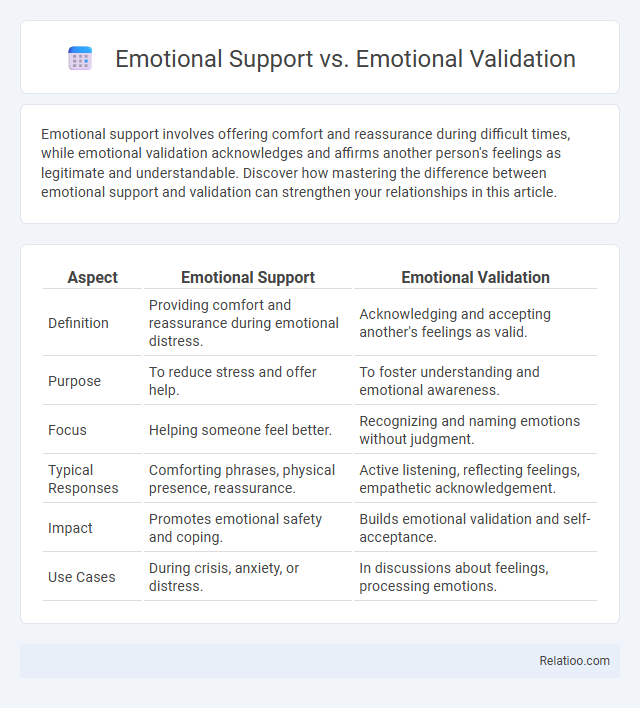Emotional support involves offering comfort and reassurance during difficult times, while emotional validation acknowledges and affirms another person's feelings as legitimate and understandable. Discover how mastering the difference between emotional support and validation can strengthen your relationships in this article.
Table of Comparison
| Aspect | Emotional Support | Emotional Validation |
|---|---|---|
| Definition | Providing comfort and reassurance during emotional distress. | Acknowledging and accepting another's feelings as valid. |
| Purpose | To reduce stress and offer help. | To foster understanding and emotional awareness. |
| Focus | Helping someone feel better. | Recognizing and naming emotions without judgment. |
| Typical Responses | Comforting phrases, physical presence, reassurance. | Active listening, reflecting feelings, empathetic acknowledgement. |
| Impact | Promotes emotional safety and coping. | Builds emotional validation and self-acceptance. |
| Use Cases | During crisis, anxiety, or distress. | In discussions about feelings, processing emotions. |
Understanding Emotional Support
Emotional support involves offering empathy, comfort, and reassurance to help You cope with difficult feelings, providing a safe emotional space. Emotional validation acknowledges and accepts Your emotions as legitimate, which deepens trust and connection without necessarily solving problems. Bridging connects emotional experiences between individuals, facilitating mutual understanding and shared emotional growth.
Defining Emotional Validation
Emotional validation involves recognizing and affirming another person's feelings as understandable and legitimate, fostering trust and emotional safety in relationships. Unlike emotional support, which offers comfort or assistance, validation specifically acknowledges the validity of emotions without necessarily trying to fix the situation. Bridging connects differing perspectives by creating mutual understanding, while emotional validation centers on empathic acknowledgment that strengthens emotional connection.
Key Differences Between Emotional Support and Validation
Emotional support involves providing comfort, reassurance, and care to help someone cope with distress, while emotional validation specifically acknowledges and accepts another's feelings without judgment or dismissal. The key difference lies in the intention: emotional support aims to soothe and offer assistance, whereas validation focuses on recognizing and affirming emotional experiences as legitimate. Bridging combines these approaches by both validating emotions and offering supportive responses to foster understanding and connection.
The Role of Empathy in Both Practices
Empathy serves as the cornerstone of both emotional support and emotional validation by enabling individuals to deeply understand and resonate with another's feelings, fostering genuine connection and trust. In emotional support, empathy drives active listening and compassionate responses, offering comfort and reassurance during distress. Bridging leverages empathy to connect differing emotional perspectives, facilitating mutual understanding and resolving conflicts through shared emotional experiences.
Emotional Support: Methods and Examples
Emotional support involves providing reassurance, empathy, and comfort to help someone manage their feelings during difficult times. Methods include active listening, expressing understanding through phrases like "I'm here for you," and offering physical presence or a supportive touch. You can strengthen relationships by consistently validating feelings and bridging gaps through open communication and genuine care.
Emotional Validation: Techniques and Benefits
Emotional validation involves acknowledging and accepting another person's feelings without judgment, using techniques such as reflective listening, empathetic responses, and affirming statements. These techniques help individuals feel understood and supported, reducing feelings of isolation and promoting emotional regulation. The benefits of emotional validation include strengthened relationships, enhanced self-esteem, and improved mental health by fostering a safe environment for emotional expression.
Common Misconceptions About Emotional Support and Validation
Emotional support is often misunderstood as simply agreeing with someone's feelings, while emotional validation means acknowledging and accepting those feelings without judgment. Many believe emotional validation requires fixing problems, but it primarily involves recognizing emotions as real and understandable. Your ability to distinguish between support, validation, and bridging--connecting emotions to solutions--enhances meaningful communication and strengthens relationships.
Impact on Relationships: Support vs Validation
Emotional support offers comfort and reassurance during distress, fostering a sense of safety and connection in relationships. Emotional validation acknowledges and affirms feelings as legitimate, enhancing trust and deepening emotional intimacy. Bridging combines support and validation, effectively addressing emotional needs and resolving conflicts to strengthen relational bonds.
When to Offer Support vs When to Validate
Emotional support involves offering comfort and reassurance during times of distress, while emotional validation acknowledges and affirms someone's feelings without judgment. You should offer support when the individual seeks help coping or needs encouragement to navigate challenges, and provide validation when their emotions need to be recognized and understood to foster connection. Bridging occurs by combining both approaches, ensuring your response meets the emotional and psychological needs effectively.
Building Emotional Intelligence Through Support and Validation
Building emotional intelligence through support and validation involves recognizing and acknowledging Your feelings while providing empathetic responses that foster trust and self-awareness. Emotional support offers comfort and reassurance during distress, whereas emotional validation confirms the legitimacy of Your emotions, enhancing emotional regulation and resilience. Bridging connects these elements by facilitating open communication, promoting deeper understanding, and strengthening interpersonal connections essential for emotional growth.

Infographic: Emotional Support vs Emotional Validation
 relatioo.com
relatioo.com